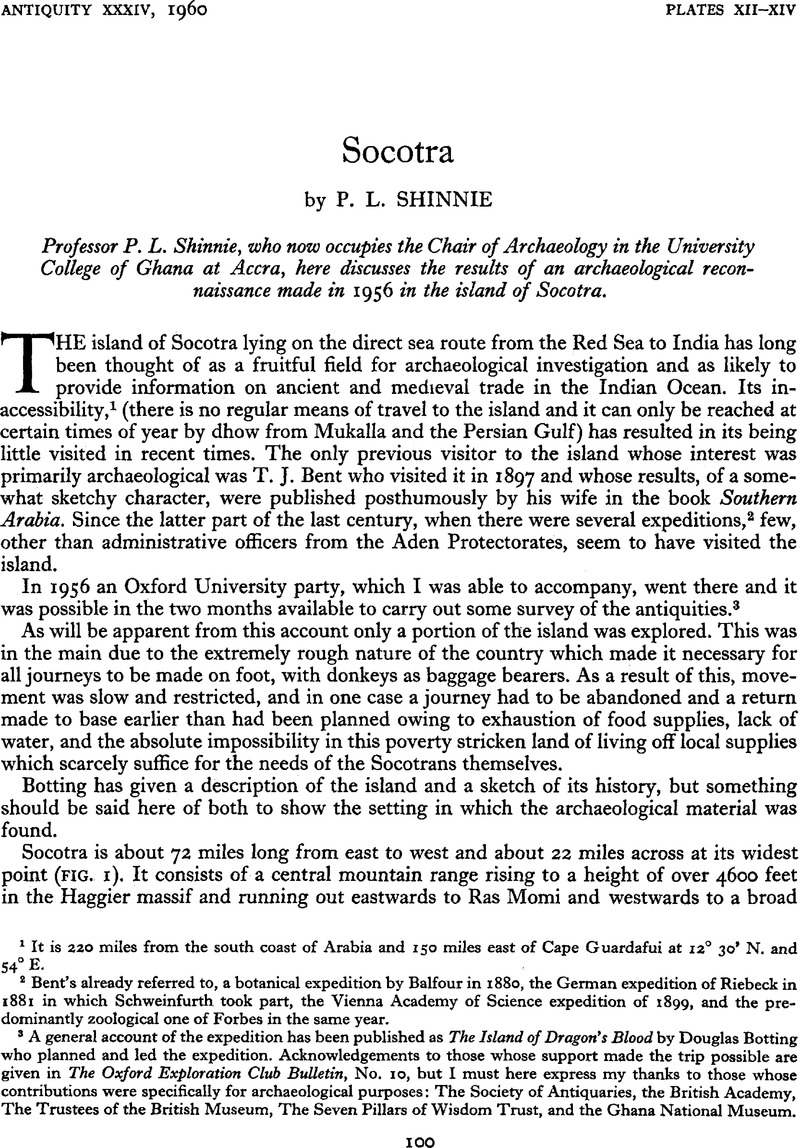Article contents
Abstract

- Type
- Research Article
- Information
- Copyright
- Copyright © Antiquity Publications Ltd 1960
References
1 It is 220 miles from the south coast of Arabia and 150 miles east of Cape Guardafili at 12° 30’ N. and 54° E.
2 Bent’s already referred to, a botanical expedition by Balfour in 1880, the German expedition of Riebeck in 1881 in which Schweinfurth took part, the Vienna Academy of Science expedition of 1899, and the predominantly zoological one of Forbes in the same year.
3 A general account of the expedition has been published as The Island of Dragon’s Blood by Douglas Botting who planned and led the expedition. Acknowledgements to those whose support made the trip possible are given in The Oxford Exploration Club Bulletin, No. 10, but I must here express my thanks to those whose contributions were specifically for archaeological purposes: The Society of Antiquaries, the British Academy, The Trustees of the British Museum, The Seven Pillars of Wisdom Trust, and the Ghana National Museum.
4 Shown on some maps by the name of Tamarida.
5 Nat. Hist., VI, 153.
6 Schoff’s edition, 33, 34.
7 Socotra now forms part of the Sultanate of Qishn and Socotra. Qishn being the capital of the Mahra country on the mainland of the eastern Aden Protectorate. This link seems a long-standing one.
8 It is used as a pigment.
9 Amongst these may be mentioned el Hamdani, Yakut, and Idrisi.
10 Bent, Southern Arabia, 355.
11 The Commentaries of the Great Afonso Dalboquergue. Hakluyt Society, vol. LIII, 1875, 44-56.
12 Purchas his Pilgrims, Pub. Maclehose, IV, 321.
13 Purchas his Pilgrims, loc. cit.
14 Bent, op. cit. 363.
15 Balfour says that the trenches were still visible when he was there in 1880. Balfour, Botany of Socotra. Transactions of the Royal Society of Edinburgh, vol. 31.
16 A number of others in the hills further to the west were visited by Dr Orr who collected skeletal material from them.
17 Described by F. M. Hunter, Journal Royal Anthropological Institute, VII, 371.
18 Bent, op cit., 384.
19 Professor R. B. Serjeant in a personal communication tells me that from the photograph it looks to him much like forts he has seen in South Arabia.
20 Some were copied by Hunter, loc. cit., and by Riebeck and Schweinfurth (Glaser, Stazze, II, 184) but were apparently never published.
21 It is marked on Balfour’s map.
22 Bent, op. cit., Appendix IV.
- 7
- Cited by




